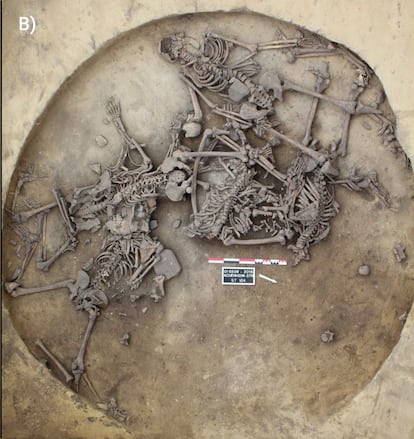Extreme war violence and collective punishment are revealed in Neolithic mass graves.

That was more than a massacre: it was a warning. More than 6,000 years ago, in what is now Alsace, northeastern France, a Neolithic human community buried the bodies of an enemy group defeated in battle, but before doing so, they staged a truly violent spectacle. Some had their left arms torn off, others had their tibias split, and their skulls smashed, then pierced, hung in plain sight, and displayed as war trophies.
What remains of that display of warlike sadism have been recovered from two sites, one in Achenheim and the other in Bergheim. The archaeologists, who published their findings this Wednesday in the journal Science Advances , concluded that this is one of the oldest and clearest evidences of ritual victory celebrations in Europe. They also interpret that the brutality served not only to eliminate the enemy, but also to display power, honor the fallen, and consolidate the identity of the victorious group.
An international team of researchers has reconstructed the deaths of 82 individuals buried in mass graves, belonging to two different groups. Some have complete bodies, although they were cruelly murdered, while only the left arms of others were found. "We believe that the communities represented in the graves correspond to populations that came from outside and were defeated by the locals," explains Javier Ordoño, one of the Spanish archaeologists behind the research.
What is known is that between 4300 and 4150 BC, in the Alsace region, there was a replacement of local residents, who clashed with groups arriving from the basin where Paris is today. This process generated conflict and wars. “The Rhine Valley—which marks the natural border between France and Germany—has always been a population transit corridor and also a zone of border and conflict,” notes Ordoño. The researcher adds that “even in recent times, and in conflicts like World War II, the area has played that role.” It was no different in the Neolithic period. “Various groups passed through there, some of which clashed with those already settled,” the archaeologist points out. Fearing the unknown, local groups reacted with disproportionate violence.
Near the mutilated bodies, there are a series of more traditional burial sites, where the inhabitants are believed to have buried members of their tribe. This allowed them to compare local individuals with outsiders and draw some conclusions. Using multi-isotopic analysis techniques—in which samples of carbon, nitrogen, sulfur, oxygen, and strontium from the corpses were analyzed in the laboratory—the researchers found significant differences between the victims of violent rituals and the rest.
At Bergheim, the butchered bodies had higher nitrogen levels, suggesting different diets—perhaps richer in animal protein—or greater episodes of physiological stress than the remains of the locals. They also revealed much greater variability in sulfur values, indicating that they did not come from the same region as the nonviolently buried residents. Even more interesting: within the victims themselves, complete skeletons and severed arms had different values, suggesting different origins among those who arrived from outside.
A period of extreme violenceAnalysis of teeth recovered from the graves made it possible to trace the childhood and youth of those buried. Although the victims and the rest shared a similar duration of lactation and weaning, the isotopic profiles of the outsiders reflect greater episodes of stress and mobility. Furthermore, strontium showed that the butchered individuals had more nomadic childhoods, changing geological environments, unlike those buried conventionally. This reinforces the idea that the victims were outsiders.
From this point on, the story becomes a little more opaque. And extremely violent. Archaeologists have interpreted these deposits as celebrations of military victories. Ordoño explains: "Public violence played a central role in the social cohesion of these Neolithic peoples." The author adds that "these were victory rituals that dehumanized the enemy and, at the same time, strengthened the community spirit." This bloody phenomenon ultimately served to honor their own fallen and to celebrate victory, reinforcing the group's internal cohesion.

This is the researchers' hypothesis: once captured, the outsiders were taken prisoner and taken to the villages for public display. There, they were tortured in front of everyone, and their remains were displayed. "We're capable of this in order to defend ourselves," was the message. According to the archaeologists who authored the new study, the executions were part of a "political theater" where violence was not only excessive but also ritualized.
The symbolism underlying this ritual is not entirely clear. It is unknown, for example, why only the left arms were amputated, always the left ones. The study speculates that it could be related to the defensive function of that arm, since it is the one that usually carries the shield. "The greatest enigma is to precisely determine the origin of these foreign populations and understand why some are preserved with their entire bodies and others only with severed arms," the archaeologist summarizes.
Migratory tensions in prehistoryThis wasn't an isolated event. "The Neolithic is considered the most violent period in human history," Ordoño points out. It was during this time that the human population began to grow, the first land ownerships were established, and social hierarchies became more evident. All of this generated violent clashes, massacres, and wars for control of resources.
“Although archaeologists sometimes abuse the idea of social change to justify certain human behaviors of the past, it's clear that moments of conflict, migration, and displacement generate tensions, and there were tensions during that period,” Ordoño reflects. “We see it even today,” he adds. “Migrations often spark resistance and, in some cases, violence. The same thing happened in prehistory: when survival was at stake and an external threat was perceived, brutal responses arose.”
Thanks to technological advances in archaeology, these bones now function as veritable "hard drives filled with information," the scientist explains. These new genetic and biological analysis methodologies are giving researchers an increasingly clear picture of how these human communities lived and, above all, how they died.
EL PAÍS





